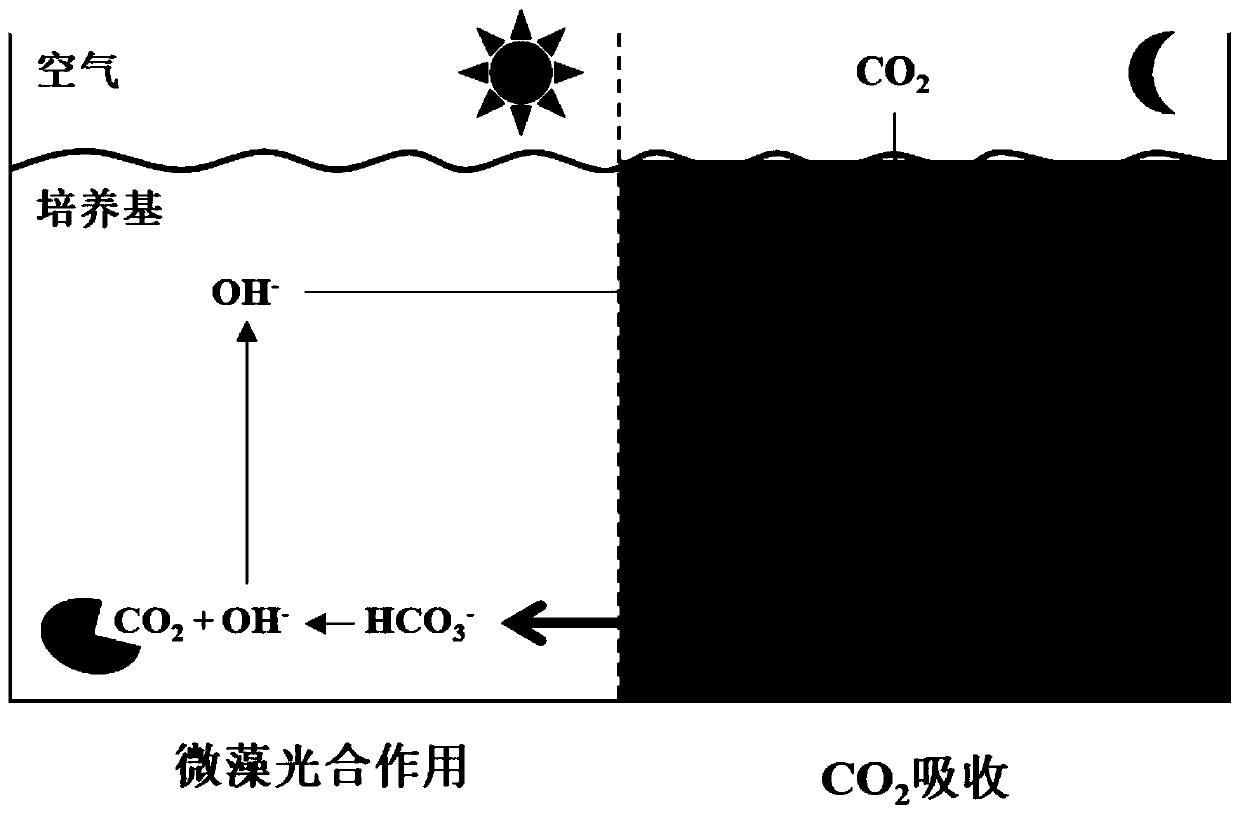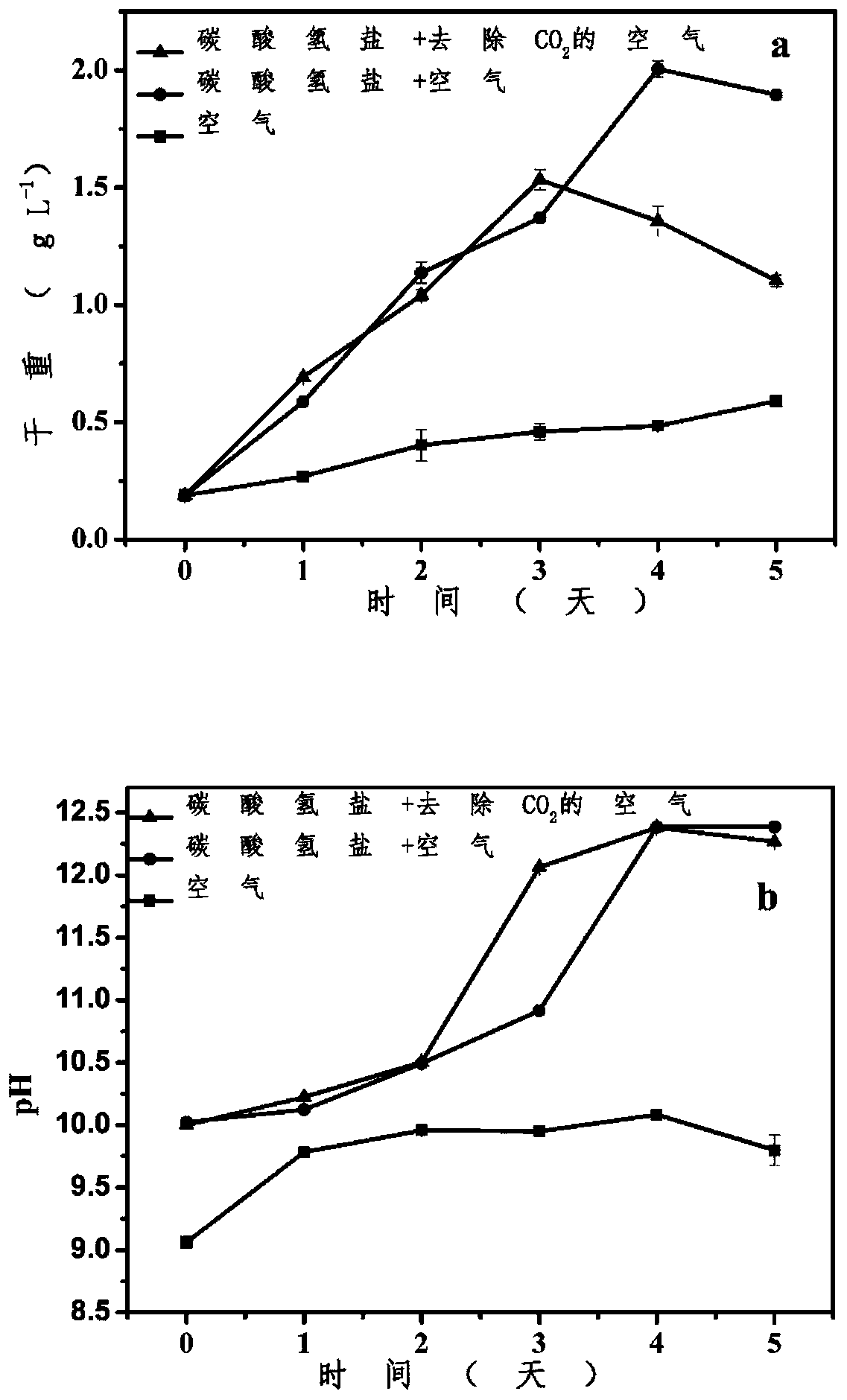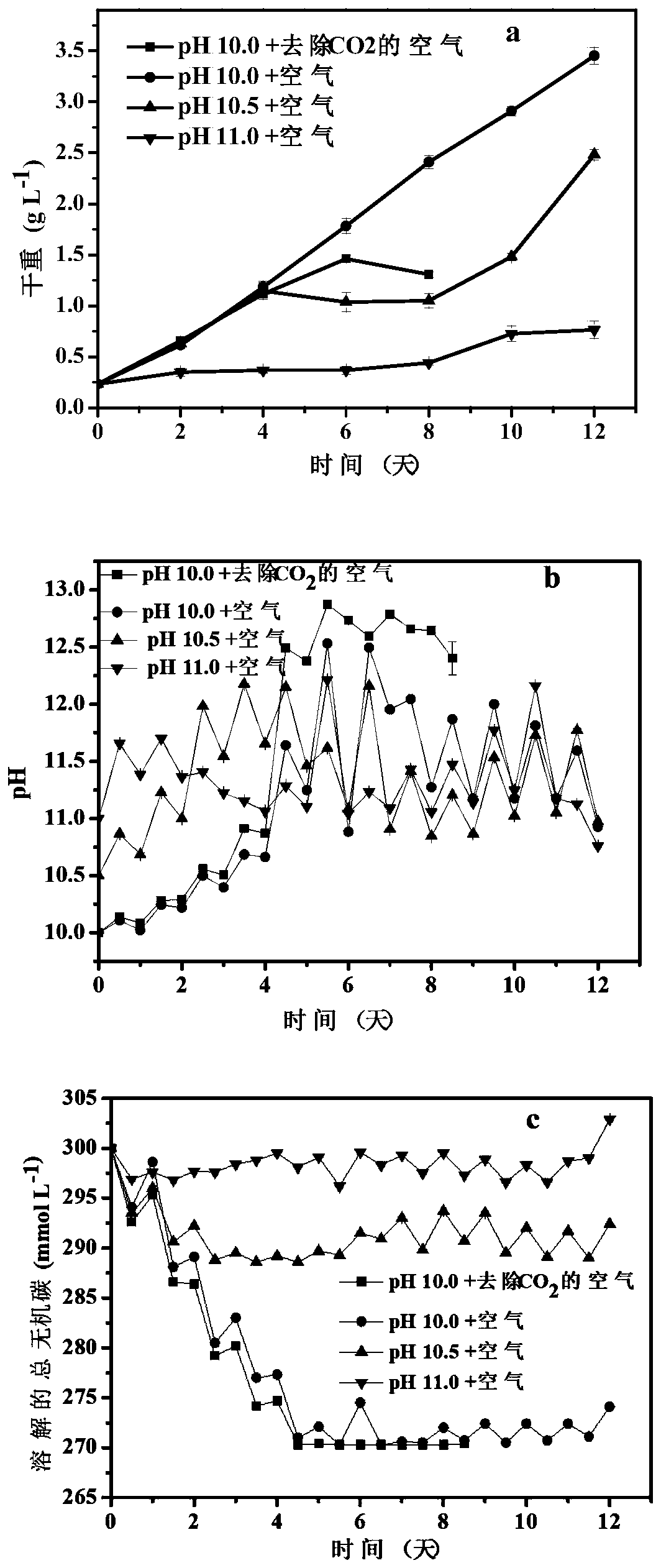Method for efficiently capturing and utilizing CO2 from air based on microalgae biotechnology
A biotechnology, CO2 technology, applied in the field of efficient capture and utilization of CO2 from the air based on microalgae biotechnology, can solve the problems of carbon mass transfer and carbon utilization out of sync, and achieve the goals of reducing production costs, efficient utilization, and efficient growth Effect
- Summary
- Abstract
- Description
- Claims
- Application Information
AI Technical Summary
Problems solved by technology
Method used
Image
Examples
Embodiment 1
[0048] The influence of carbon pool on the growth of source spirulina under the continuous light of embodiment 1
[0049] First prepare the following medium without inorganic carbon: 2.5g L -1 NaNO 3 , 1.0g L -1 NaCl, 0.04gL - 1 CaCl 2H 2 O, 1.0 g L -1 K 2 SO 4 , 0.5g L -1 K 2 HPO 4 , 0.2g L -1 MgSO 4 ·7H 2 O, 0.01gL -1 FeSO 4 ·7H 2 O, 1.979 g L -1 MoCl 2 4H 2 O, 3.092 L -1 h 3 BO 3 , 0.484g L -1 NaMo 4 2H 2 O, 0.23 g L -1 ZnSO 4 ·7H 2 O, 0.183 L -1 NaVO 3 , 0.048g L -1 CoCl 2 ·6H 2 O, 0.2 g L -1 CuSO 4 ·5H 2 O. NaHCO in a molar ratio of 1:1 3 –Na 2 CO 3 Ratio, add a total of 0.3mol L to the above medium without inorganic carbon -1 Inorganic carbon, the medium with an initial pH of 10.0, respectively, was obtained. As a control, add 0.3mol L -1 Sodium chloride to prepare medium containing no inorganic carbon at the same salinity
[0050] Inject the above 600mL medium containing inorganic carbon and not containing inorganic carbon in...
Embodiment 2
[0053] Example 2 Effects of different initial pH values on the growth of Spirulina and its carbon fixation
[0054] First prepare the medium that does not contain inorganic carbon as described in Example 1, then according to the NaHCO of molar ratio 1:1,1:4,1:9 3 –Na 2 CO 3 Ratio, add a total of 0.3mol L to the above medium without inorganic carbon -1 Inorganic carbon, respectively, resulted in media with initial pHs of 10.0, 10.5 and 11.0, respectively.
[0055] Inject 600mL of the above-mentioned medium with an initial pH of 10.0, 10.5 and 11.0 into a bubbling photobioreactor with a height of 30cm and a diameter of 5.0cm, and add 100ml L -1 Air is blown in at a rate. As a control, feeding into another reactor containing medium with an initial pH of 10.0 removed CO 2 air, the ventilation rate remains the same.
[0056] Finally according to 0.232g L -1 The density of Spirulina was inserted into Spirulina, and microalgae were cultured according to the following culture...
Embodiment 3
[0063] Example 3 Effect of initial bicarbonate concentration on microalgal culture and CO 2 Examples of Fixed Efficiency Effects
[0064] First prepare the culture medium that does not contain inorganic carbon as described in Example 1, then according to the NaHCO of molar ratio 1:1 3 –Na 2 CO 3 Ratio, add a total of 0.1, 0.3 and 0.5 mol L to the above medium without inorganic carbon, respectively -1 Inorganic carbon, respectively, the initial carbon source concentrations were 0.1, 0.3 and 0.5mol L -1 And the culture medium with initial pH of 10.0.
[0065] Finally according to 0.223g L -1 The density inserts Spirulina, and cultivates microalgae according to the culture method and culture condition described in embodiment 1, wherein the air that feeds is normal air, does not remove wherein CO 2 . The culture time was set to 12 days.
[0066] Such as Figure 4 As shown in a, the initial carbon source concentration has a significant impact on the growth of microalgae, a...
PUM
 Login to View More
Login to View More Abstract
Description
Claims
Application Information
 Login to View More
Login to View More - R&D
- Intellectual Property
- Life Sciences
- Materials
- Tech Scout
- Unparalleled Data Quality
- Higher Quality Content
- 60% Fewer Hallucinations
Browse by: Latest US Patents, China's latest patents, Technical Efficacy Thesaurus, Application Domain, Technology Topic, Popular Technical Reports.
© 2025 PatSnap. All rights reserved.Legal|Privacy policy|Modern Slavery Act Transparency Statement|Sitemap|About US| Contact US: help@patsnap.com



